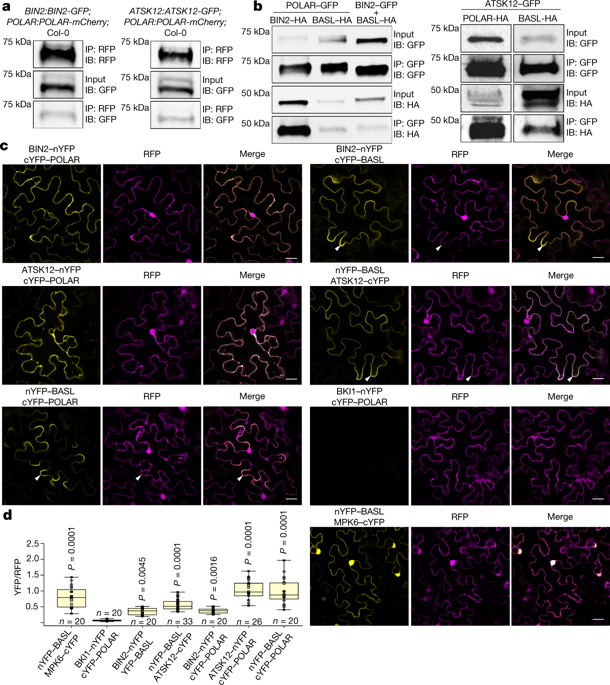Our official English website, www.x-mol.net, welcomes your feedback! (Note: you will need to create a separate account there.)
POLAR-guided signalling complex assembly and localization drive asymmetric cell division
Nature ( IF 64.8 ) Pub Date : 2018-11-01 , DOI: 10.1038/s41586-018-0714-x Anaxi Houbaert , Cheng Zhang , Manish Tiwari , Kun Wang , Alberto de Marcos Serrano , Daniel V. Savatin , Mounashree J. Urs , Miroslava K. Zhiponova , Gustavo E. Gudesblat , Isabelle Vanhoutte , Dominique Eeckhout , Sjef Boeren , Mansour Karimi , Camilla Betti , Thomas Jacobs , Carmen Fenoll , Montaña Mena , Sacco de Vries , Geert De Jaeger , Eugenia Russinova
Nature ( IF 64.8 ) Pub Date : 2018-11-01 , DOI: 10.1038/s41586-018-0714-x Anaxi Houbaert , Cheng Zhang , Manish Tiwari , Kun Wang , Alberto de Marcos Serrano , Daniel V. Savatin , Mounashree J. Urs , Miroslava K. Zhiponova , Gustavo E. Gudesblat , Isabelle Vanhoutte , Dominique Eeckhout , Sjef Boeren , Mansour Karimi , Camilla Betti , Thomas Jacobs , Carmen Fenoll , Montaña Mena , Sacco de Vries , Geert De Jaeger , Eugenia Russinova

|
Stomatal cell lineage is an archetypal example of asymmetric cell division (ACD), which is necessary for plant survival1–4. In Arabidopsis thaliana, the GLYCOGEN SYNTHASE KINASE3 (GSK3)/SHAGGY-like kinase BRASSINOSTEROID INSENSITIVE 2 (BIN2) phosphorylates both the mitogen-activated protein kinase (MAPK) signalling module5,6 and its downstream target, the transcription factor SPEECHLESS (SPCH)7, to promote and restrict ACDs, respectively, in the same stomatal lineage cell. However, the mechanisms that balance these mutually exclusive activities remain unclear. Here we identify the plant-specific protein POLAR as a stomatal lineage scaffold for a subset of GSK3-like kinases that confines them to the cytosol and subsequently transiently polarizes them within the cell, together with BREAKING OF ASYMMETRY IN THE STOMATAL LINEAGE (BASL), before ACD. As a result, MAPK signalling is attenuated, enabling SPCH to drive ACD in the nucleus. Moreover, POLAR turnover requires phosphorylation on specific residues, mediated by GSK3. Our study reveals a mechanism by which the scaffolding protein POLAR ensures GSK3 substrate specificity, and could serve as a paradigm for understanding regulation of GSK3 in plants.POLAR, identified in a survey of the protein interactome of BRASSINOSTEROID INSENSITIVE 2 in Arabidopsis thaliana, has a key role in coordinating cell polarity and enabling asymmetric cell division.
中文翻译:

POLAR 引导的信号复杂组装和定位驱动不对称细胞分裂
气孔细胞谱系是不对称细胞分裂 (ACD) 的典型例子,这是植物存活所必需的 1-4。在拟南芥中,糖原合成酶激酶3 (GSK3)/SHAGGY 样激酶 BRASSINOSTEROID INSENSITIVE 2 (BIN2) 磷酸化丝裂原活化蛋白激酶 (MAPK) 信号模块 5,6 及其下游靶标转录因子无声 (SPCH)7 , 分别在同一气孔谱系细胞中促进和限制 ACD。然而,平衡这些相互排斥的活动的机制仍不清楚。在这里,我们将植物特异性蛋白 POLAR 鉴定为 GSK3 样激酶子集的气孔谱系支架,将它们限制在细胞质中,随后在细胞内瞬时极化它们,同时打破气孔谱系 (BASL) 中的不对称性,在 ACD 之前。结果,MAPK 信号减弱,使 SPCH 能够驱动细胞核中的 ACD。此外,POLAR 转换需要特定残基的磷酸化,由 GSK3 介导。我们的研究揭示了支架蛋白 POLAR 确保 GSK3 底物特异性的机制,并可作为了解植物中 GSK3 调控的范例。 POLAR,在拟南芥中 BRASSINOSTEROID INSENSITIVE 2 的蛋白质相互作用组调查中发现,具有在协调细胞极性和实现不对称细胞分裂方面的关键作用。
更新日期:2018-11-01
中文翻译:

POLAR 引导的信号复杂组装和定位驱动不对称细胞分裂
气孔细胞谱系是不对称细胞分裂 (ACD) 的典型例子,这是植物存活所必需的 1-4。在拟南芥中,糖原合成酶激酶3 (GSK3)/SHAGGY 样激酶 BRASSINOSTEROID INSENSITIVE 2 (BIN2) 磷酸化丝裂原活化蛋白激酶 (MAPK) 信号模块 5,6 及其下游靶标转录因子无声 (SPCH)7 , 分别在同一气孔谱系细胞中促进和限制 ACD。然而,平衡这些相互排斥的活动的机制仍不清楚。在这里,我们将植物特异性蛋白 POLAR 鉴定为 GSK3 样激酶子集的气孔谱系支架,将它们限制在细胞质中,随后在细胞内瞬时极化它们,同时打破气孔谱系 (BASL) 中的不对称性,在 ACD 之前。结果,MAPK 信号减弱,使 SPCH 能够驱动细胞核中的 ACD。此外,POLAR 转换需要特定残基的磷酸化,由 GSK3 介导。我们的研究揭示了支架蛋白 POLAR 确保 GSK3 底物特异性的机制,并可作为了解植物中 GSK3 调控的范例。 POLAR,在拟南芥中 BRASSINOSTEROID INSENSITIVE 2 的蛋白质相互作用组调查中发现,具有在协调细胞极性和实现不对称细胞分裂方面的关键作用。



























 京公网安备 11010802027423号
京公网安备 11010802027423号